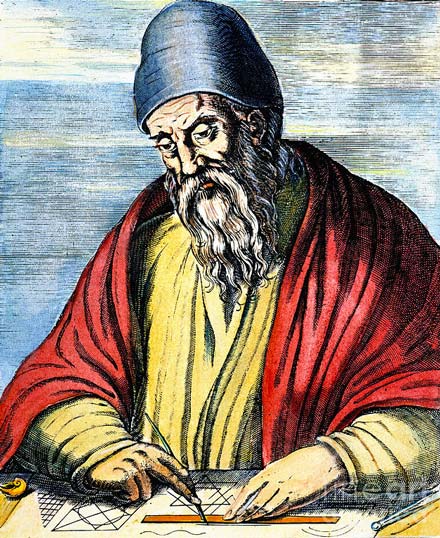Euclidean GeometryEuclid’s Axioms
Before we can write any proofs, we need some common terminology that will make it easier to talk about geometric objects. These are not particularly exciting, but you should already know most of them:
A
In Mathigon, large, solid dots indicate interactive points you can move around, while smaller, outlined dots indicate fixed points which you can’t move.
A
Lines are labeled using lower-case letters like a or b. We can also refer to them using two points that lie on the line, for example
A
A
When labelling rays, the arrow shows the direction where it extends to infinity, for example
A
Congruence
These two shapes basically look identical. They have the same size and shape, and we could turn and slide one of them to exactly match up with the other. In geometry, we say that the two shapes are
The symbol for congruence is
Here are a few different geometric objects – connect all pairs that are congruent to each other. Remember that more than two shapes might be congruent, and some shapes might not be congruent to any others:
Two line segments are congruent if they
Note the that “congruent” does not mean “equal”. For example, congruent lines and angles don’t have to point in the same direction. Still, congruence has many of the same properties of equality:
- Congruence is symmetric: if
X ≅ Y then alsoY ≅ X . - Congruence is reflexive: any shape is congruent to itself. For example,
A ≅ A . - Congruence is transitive: if
X ≅ Y andY ≅ Z then alsoX ≅ Z .
Parallel and Perpendicular
Two straight lines that never intersect are called
A good example of parallel lines in real life are railroad tracks. But note that more than two lines can be parallel to each other!
In diagrams, we denote parallel lines by adding one or more small arrows. In this example,
The opposite of parallel is two lines meeting at a 90° angle (right angle). These lines are called
In this example, we would write a
Euclid’s Axioms
Greek mathematicians realised that to write formal proofs, you need some sort of starting point: simple, intuitive statements, that everyone agrees are true. These are called
A key part of mathematics is combining different axioms to prove more complex results, using the rules of logic.
The Greek mathematician

Euclid of Alexandria
First Axiom
You can join any two points using exactly one straight line segment.
Second Axiom
You can extend any line segment to an infinitely long line.
Third Axiom
Given a point P and a distance r, you can draw a circle with centre P and radius r.
Fourth Axiom
Any two right angles are congruent.
Fifth Axiom
Given a line L and a point P not on L, there is exactly one line through P that is
Each of these axioms looks pretty obvious and self-evident, but together they form the foundation of geometry, and can be used to deduce almost everything else. According to none less than
Euclid published the five axioms in a book “Elements”. It is the first example in history of a systematic approach to mathematics, and was used as mathematics textbook for thousands of years.
One of the people who studied Euclid’s work was the American President
This is just one example where Euclid’s ideas in mathematics have inspired completely different subjects.